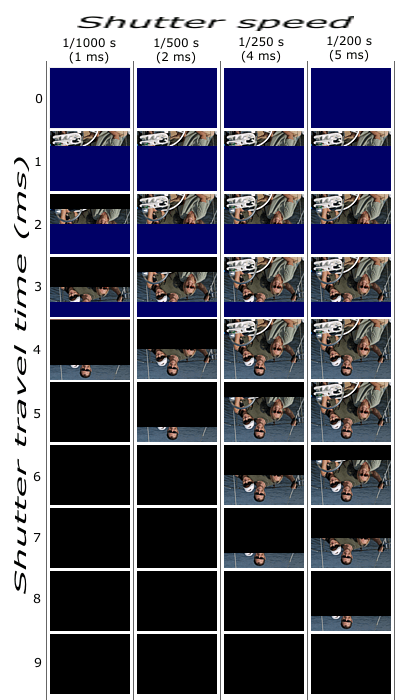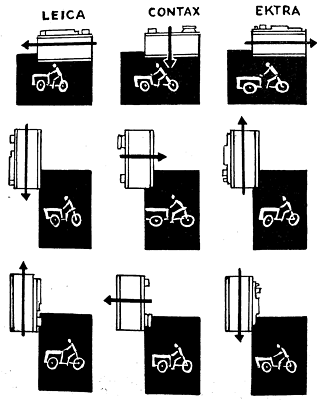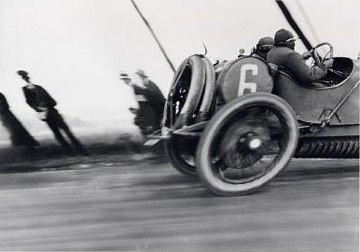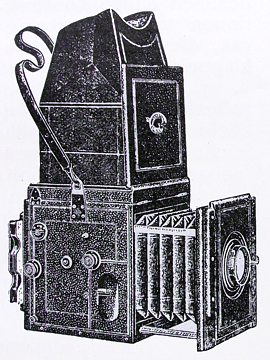
with articles on technical aspects of photography.
|
How does your focal plane shutter work? |

|
Back to the Nitty-Gritty section, with articles on technical aspects of photography. |
|
Just for the record: a shutter in your camera is a device whose sole task is to regulate the time of exposure of your sensor (or film) to the image-forming light incoming from the lens. Yes, you knew that, but maybe one day you will bring here a friend who does not.
A film camera always needs a shutter. Some digital camera sensors, however, allow for electronic gating of the signal: the response of sensor to light is collected within (and averaged over) only a certain amount of time, adjusted by the circuitry. Even those, however, may need some period (a fraction of a second) in the dark before the actual exposure, so they may need a kind of shutter, closing just before the exposure and re-opening for it, even if it does not actually set the effective exposure time. In either case, the more advanced the camera is (and the better image quality it delivers), the greater are the chances that it will have a shutter, not just an "electronic shutter" (which, actually, is not a shutter at all), but a mechanical one, albeit electronically controlled. Two kinds of shutters, differing greatly in the way how they work, are most common. Leaf shutters
One is the leaf shutter, sitting usually (but not always) within the lens; opening and closing in a sequence as shown in this picture.
|
| 
|
Because the leaf shutter is located far away from the image plane, all points of the image are exposed to light at the same time. This is a plus when shooting with flash, as its very short light burst (about 1/1000 s or even less) can be captured in the whole image at any shutter speed (as you will see, the other type of shutter allows for flash use only with exposures longer than a certain value). It is a definite advantage when using flash as a fill-in outdoors.
A limitation of a leaf shutter is that it needs some time to open fully (and than, again, to close): during those two phases the lens is partially obstructed and your sensor gets less light than it should. Obviously, when you increase the shutter speed, at some value the shutter will have to start closing as soon as it opens; that's why the maximum speed of leaf shutters is often limited to 1/500 s or 1/1000 s. (Some leaf-shutter cameras go up to 1/2000 s or higher, but I suspect there is electronic gating involved here.) In the digital world, leaf shutters are used exclusively in non-SLR cameras. The only exceptions were the E-10 and E-20 from Olympus, SLRs with non-interchangeable zoom, and the highest shutter speed of 1/640 s, which led to lots of complaining. Focal plane shutters Focal plane shutters have been around for a long time, at least since the end of the XIX century. In this design, a slot between two cloth curtains (now they are made of metal or plastic composites) is moving immediately in front of the image plane (film or sensor). Even if the slot is not moving very fast, the exposure time is equal to the time it takes the curtains to travel over the slot width. That width is used to adjust the exposure time (referred to as shutter speed), while the actual velocity with which the curtains are moving remains unchanged. At longer exposures the second curtain will start closing well after the first one is fully open, so it is hard to speak about a "slot"; the thing works more like a window, opening entirely and then closing again. Because the slot is moving immediately in front of the film (sensor), various points (or rather bands) of the image are exposed at various time, although each gets the same length of exposure, assuming the shutter is not malfunctioning. This will be discussed in more detail, and illustrated with an example, in the next section. Here let me only say that the focal plane shutter, facilitating the use of interchangeable lenses (in addition to being capable of shorter exposure times), became a standard in film SLRs and also in the more advanced rangefinder cameras, starting from the original Leica prototype almost a hundred years ago. With all the progress in technology, the design principles of this type of shutter remained unchanged over that time; an amazing longevity of the concept. Among digital cameras, only SLRs are using focal plane shutters (oops, sorry, we've got the Leica M8; I know a guy who knows a guy who has one, or maybe there is one more guy involved in the middle). I would expect the focal plane shutter era to end only with the arrival of high-quality sensors capable of gating the signal; this will take a few years more. (Unless someone finds a way to use the Kerr effect, or something similar, to change the opacity of the anti-aliasing filter in front of the sensor; just a thought...) How do they work Here is ten milliseconds from the life of a typical focal-plane shutter in a digital camera. The simulated sensor (film) area is shown in its real orientation, with the image formed by the lens being upside down. In this illustration I have assumed a vertical shutter, traveling from top to bottom, as this seems to be the most common type today, especially in digital SLRs. The principle remains the same regardless of the travel direction. For simplicity I've also assumed that the shutter curtains need 1/250 s to travel the full frame height; this also is quite typical for modern SLRs, allowing for flash synchronization at shutter speeds up to about 1/200 s. For example, the Canon 400D (Digital Rebel XTi) provides flash synchronization up to 1/200 s, the Nikon D200 goes up to 1/250 s, The Pentax K10D to 1/180 s, and the E-System cameras by Olympus also claim 1/180 s (although I successfully tested the E-300 and E-500 at 1/320 s, far exceeding the official specs). Anyway, the 1/250 s travel time is typical and reasonable. Note that with this travel speed a shutter curtain covers exactly 1/4 of the frame height in one millisecond (ms). This is a handy, round value. So what happens after the shutter is tripped? Have a look at what the sensor (film) plane can "see" at different time instants after the shutter starts its travel, and for four different shutter speeds (shown in separate columns). The first curtain (C1) is shown in blue; the second (C2) — in black.
0 ms: C1 is just about to open in all four exposures, but still covers the whole frame.
| 1 ms: C1 opened 1/4 of the frame; C2 is about to start in the 1/1000 s exposure, but still far from that in others. 2 ms: C1 half-way down the frame; C2 already closed the top 1/4 in the 1/1000 s exposure, about to start closing the 1/500 s one. 3 ms: C1 3/4 down; C2 half-way (1/1000 s) or 1/4 down (1/500 s), still waiting in other exposures. 4 ms: C1 fully open; C2 well under way in the first two exposures, still fully open in the others (but about to start in 1/250 s). This is when the flash usually fires. 5 ms: The 1/1000 s exposure is done (C2 closed); in 1/250 s the flash did not have enough time to burn out before C2 started, but the 1/200 s is still fully open! If the flash burst lasted 1/1000 s or less, the fourth frame will be fully covered by its illumination. 6 ms: C2 is closing down in the two slower exposures, but will be still open at ones longer than 1/200 s. 7 ms: The two shorter exposures are history; in the longer ones C2 is still closing down. 8 ms: Even the 1/200 s exposure ic coming to an end... 9 ms: All exposures faster than 1/200 s are done, C2 fully closed. (If you are shooting at 1/125 s, not shown here, the frame is still fully exposed to light, with C2 just about to start its travel.) Note that the speed with which both curtains travel down the frame is the same for all shutter speeds; what changes is the delay with which the second curtain starts after the first one.
| 
|
If you understood the above sequence and the examples shown (if not, go back and follow each column from the top down; it is worth the effort!), you will have no problem realizing a number of things that follow.
Why don't they...
First of all, the common complaint: "why don't they provide higher shutter speeds beyond Well, you can increase the maximum shutter speed in two ways:
Neither of these comes free. For the frame height of 15 mm (close enough to both APS-C and Four Thirds standard), the travel time of 1/250 s means a speed of 15*250 mm/s, or 3.75 m/s. That's the speed with which a hammer dropped from 72 cm (almost 2.5 ft) hits your toenail. Ouch. Doubling that speed would be equivalent to quadrupling the drop height to 2.9 m (or 9.5 ft). Ouch, ouch. Obviously, the amount of energy needed to get this speed would quadruple as compared to the original: the curtains are not weightless. This speed cannot arise instantaneously. Each curtain has to gain the full travel speed before it passes in front of the top of the frame. Then they have to decelerate from that speed to zero. This means that the shutter has to be larger than the frame size. Let me assume, just for the sake of argument, an extra 10% (1.5 mm) on either side. To accelerate from zero to 3.75 m/s along a 1.5 mm path we need an average acceleration of 9375 m/s2 or almost 1000 g (with 'g' being the Earth's gravitational acceleration). This means your curtains have to accelerate a thousand times more rapidly than a falling hammer! Doubling the curtain speed would require doubling that acceleration. This, obviously, affects the longevity of the shutter. OK, maybe it is not 1.5 mm, but 3 mm on each side; we are still talking about 500 g, and that's a lot.
The other approach, narrowing the curtain slit, may be easier and less expensive — up to a certain point. Except for the Nikon D200, all cameras mentioned above have a maximum shutter speed of The one camera different than the others in our small comparison was the Nikon D200, with the highest shutter speed of 1/8000 s. Because the Nikon offers flash synchronization at the same speed as the other brands, I am assured they attain 1/8000 s in the second way, i.e., by narrowing the shutter slit to a bit less than 0.5 mm. Not an easy task, and an indication of advanced manufacturing capabilities, at least in their upscale models — the entry-level D40 is, at 1/4000 s, with the rest of the crowd. By the way, the Canon 30 D uses the same approach; looks like we've reached the limit of curtain travel speeda, at least until some new technology pushes it back again. Flash synchronization As we could see, the shortest exposure time at which a focal plane shutter can be synchronized with an electronic flash is limited; in the best case it will be equal to the curtain travel time plus the duration of the flash burst. In most cases this is not a problem: if the flash itself is the main source of light (as is usually the case indoors), then the effective exposure time is defined not by the shutter speed but by the flash duration: you can shoot fast-moving subjects at 1/125 s or slower, and the movement will still be frozen by the flash of 1/1000 s or shorter. After all, for most of the film SLR era, well into the Seventies, the synchronization was limited to 1/30 of a second, and only with the vertical-travel shutter it was cut down to 1/60 s, then even more. In the Eighties 1/90 s was a good value. Note that a full-frame camera, with the image 24 mm tall, requires a curtain travel speed 1.6× larger than the value we've arrived to, in order to provide flash synchronization at 1/200 s. This, together with the greater area and weight of the shutter curtains, does not certainly come free. The problems start arising when you want to use a flash as a fill-in outdoors, to lighten up the shadows. This, at certain combinations of light conditions and aperture, may call for shutter speeds above 1/200 s or whatever your camera's limit is. Some manufacturers (including Olympus) came up with a work-around. Instead of emitting a single, intense burst of light when the shutter becomes fully open, this approach involves lower-intensity, densely spaced bursts which start as soon as the first curtain starts opening, and end when the second one closes. I will discuss this in more detail in an upcoming article on flash photography. | |||
|
One of the less-known features of focal-plane shutters is that they introduce some degree of geometric distortion. Look again at the sequential illustration at 1/1000 s above: note that the bottom part of my subjects (shown at the top of the inverted frame) was recorded about 4 milliseconds earlier than the top. If my subjects were moving across the frame, they would be slanted to the side! If the subject moves parallel to the shutter direction, there will be no slant visible, but the subject's image will be either compressed or stretched along that axis. With high curtain travel speeds in modern cameras, the effect is difficult to notice. How much will a subject move in 1/250 of a second? For all practical purposes this can be neglected with fast-travel shutters. Consider a box-shaped milk truck moving across the lens axis at 60 mph (96 km/h, or 27 m/s) at the distance of 10 meters (30 ft) from the camera as in our scenario above. (Better use a 1/4000 s speed to capture that!). With a "standard" 25 mm lens the vertical shutter travel velocity translates into 10/.025×3.75 or 1500 m/s when projected into the subject plane. 27/1500 is about 1/50; the subject rectangle will be therefore slanted by one part in fifty, or just above 1° of angle. Cut the distance in half (or double the focal length to 50 mm) and you will get 2°. You may see the effect, but it will not be really obvious.
| 
| Many of the film SLRs being still in use have shutter curtains which need 1/60 s for the full travel. With these, the slant in our example will be four times greater, about 4° or 8°, respectively — and this will be hard to miss. For a classic SLR, synchronizing only up to 1/30 s, the effect will be twice as pronounced, although you have to remember that it depends on the relationship between the curtain travel direction, camera orientation, and subject movement. For your entertainment, here is a reproduction of a drawing from one of the old Polish photography books in my collection: Techniques of Modern Photography by T. Cyprian, published in 1949 (no, I'm not that old; just bought the book visiting Warsaw a few years ago). It shows the geometry distortion caused by focal plane shutters, as dependent on these factors. Interestingly, the example cameras chosen were Leica and Contax (two rangefinder legends), but also the Kodak Ektra. The Contax column is applicable to the modern digital SLRs — nihil novi sub sole!
| Jaques-Henri Lartigue's best photograph
Perhaps the most famous case when the geometric distortion caused by a focal-plane shutter adds a creative effect to an image is a picture shot by Jaques-Henri Lartigue in 1912, when he was | ||
|
Note that the wheel is tilted to the right (in the direction of car movement), while the spectators and poles in the background — to the left, even after you account for the slanted horizon. This indicates that the camera was using a vertical-travel, top-to-bottom, focal plane shutter, while it was panning to the right, but not catching up with the car. From camera's viewpoint, the car was still moving to the right, the background to the left. The top of the scene (or bottom of the image plane) was exposed well after the opposite edge, therefore each is tilting in its respective direction of the (relative) movement. This is a situation exactly like in the top-center example in the drawing above. (By the way, have you noticed how the wheels of racing cars are often drawn in comic books?) |
 J. H. Lartigue: ACF Grand Prix, Delage racing car, Dieppe, June 26, 1912 © Ministčre de la Culture-France and AAJHL (This is a low-resolution representation of an iconic work of art; to the best of my understanding, within the fair use restrictions) |
|
Sources indicate that Lartigue was using at the time one of the Ica Reflex cameras, made by the company named ICA in Dresden (where else?), which was for about seventy years the leading camera manufacturing center in the world. | |

ICA Spiegelreflex-Künstlerkamera System Raupp (1909) From Ratgeber im Photographieren by Ludwig David, 75-78 Ed, 1914 |
At least two ICA SLR model families of that time meet this description: one was the ICA Spiegelreflex-Kamera Tudor (1912) and the other, more likely, the ICA Spiegelreflex-Künstlerkamera System Raupp (1909, shown at left), not to be confused with the ICA Klappreflex-Künstlerkamera of 1920.
I'm quoting those names because I just love them, how much better than just a D-12 or Digital Hobo. They were also meaninful: Spiegelreflex usually refers to an SLR with a rigid mirror box, while Klappreflex or Spiegelreflex-Klappkamera — with the mirror chamber within collapsible bellows, which made the camera much more compact when folded. While the System Raupp ICA cameras were made for six (!) different frame formats, from 6×9 to 13×18 cm, and the Tudor for 9×12 and 10×15 cm, this particular version used 9×12 cm glass negative plates (with an option for reversible, two-plate holders). It had a vertical-travel, cloth, focal-plane shutter with speeds up to 1/1000, and a viewing mirror, which you had to move up by hand before tripping the shutter, therefore shooting blind. This, ironically, explains why the car partially ran away from the frame, creating a strong (although, most probably, unintentional) artistic effect. |
|
So what really happened: the kid went to the races, missed the shot, put the print into a scrapbook, saved the negative plate — and in a few years set out for a career in painting. The picture was re-discovered fifty years later, along with a number of other (equally strong) images, and the author, well in his seventies, became an instant celebrity in the photography world (although he was pursuing this as a hobby, and not only, through his whole life). If you are interested in more, Peter Marshall's in-depth article on Lartigue is a reading I've enjoyed a lot. Instead of conclusion There are two things worth remembering from this article:
| |

|
Back to the Nitty-Gritty section, with articles on technical aspects of photography. |
| Home: wrotniak.net | Search this site | Change font size |
| Posted 2007/02/13; last updated 2019/03/29 | Copyright © 2007-2017 by J. Andrzej Wrotniak |